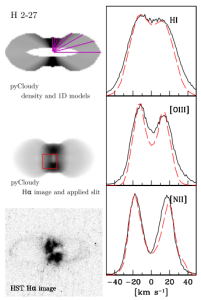4.4 Today´s new entry:
3D pyCloudy modelling of bipolar planetary nebulae: evidence for fast fading of the lobes
K. Gesicki, A. A. Zijlstra, and C. Morisset
Abstract: We apply an axially symmetric pseudo-3D photoionization model, pyCloudy, to derive the structures of 6 bipolar nebulae and 2 suggested post-bipolars in a quest to constrain the bipolar planetary nebulae evolution. HST images and VLT/UVES spectroscopy are used for the modelling. The targets are located in the direction of the Galactic bulge. A 3D model structure is used as input to the photoionization code, so as to fit the HST images. Line profiles of different ions constrain the velocity field. The model and associated velocity fields allow us to derive masses, velocities, and ages. The 3D models find much lower ionized masses than required in 1D models: ionized masses are reduced by factors of 2-7. The selected bi-lobed planetary
nebulae show a narrow range of ages: the averaged radii and velocities result in values between 1300 and 2000 yr. The lobes are fitted well with velocities linearly increasing with radius. These Hubble-type flows have been found before, and suggest that the lobes form at a defined point in time. The lobes appear to be slightly younger than the main (host) nebulae, by ~500 yr, they seem to form at an early phase of PN evolution, and fade after 1-2 kyr. We find that 30-35% of bulge PNe pass through a bipolar phase.
Journal: Astronomy & Astrophysics, in press
URL of preprint: http://arxiv.org/abs/1509.08017
Submitted by: K. Gesicki

